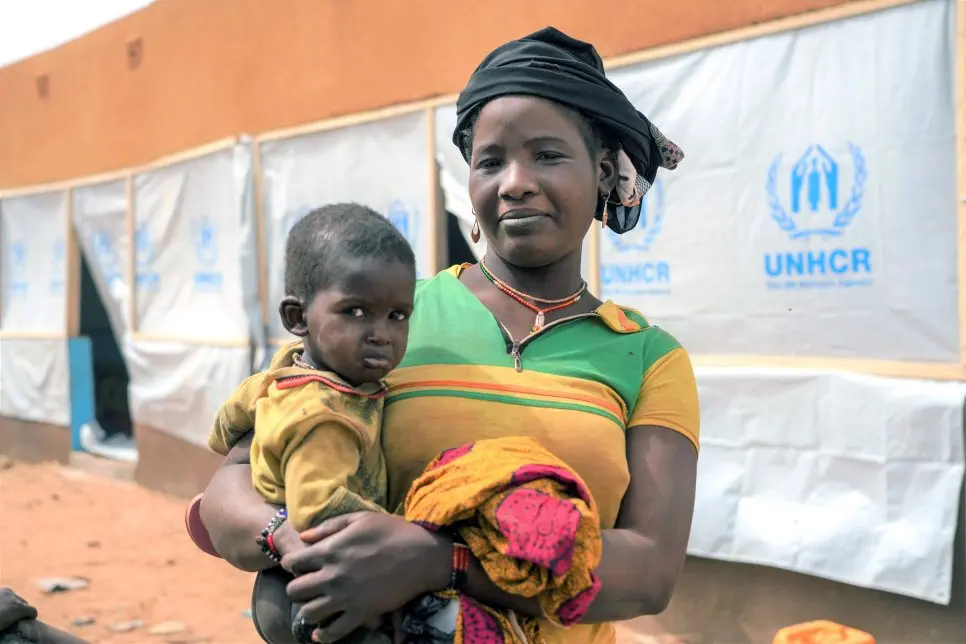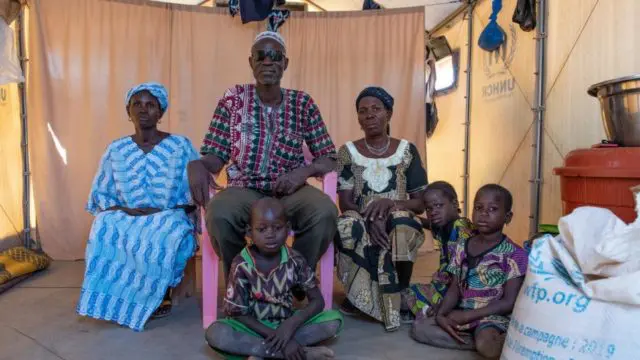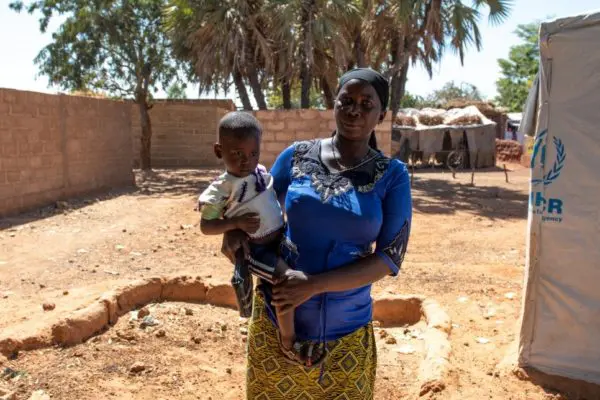
Aissata, who arrived from Djibo, holding her baby boy. She joins other Malian refugees returning to a reopened Goudoubo camp. © UNHCR/Moussa Bougma
The Goudoubo camp, empty after violence forced residents out, now bustles as schools and healthcare centres rebuild and businesses reopen.
By Moussa Bougma
Ouagadougou, BURKINA FASO – When Aissata, a 29-year-old mother of three, fled violence in her home country of Mali two years ago, she sought safety in neighbouring Burkina Faso, moving into the Mentao refugee camp with her extended family. But in the Sahel region – a swathe of land that encompasses several countries south of the Sahara – violence easily crosses borders.
DONATE TO SUPPORT REFUGEES IN THE SAHEL
“We were forced to flee once again,” said Aissata, who took her family to the nearby town of Djibo after a series of violent attacks by armed groups and reprisals by the security forces made the Mentao refugee camp unlivable.
Aissata thinks she finally may have found refuge.
Last month, UNHCR, the UN Refugee Agency relocated 1,200 Malian refugees, including Aissata and her family, from Djibo to another camp, Goudoubo, roughly 200 kilometres away. There, they will have access again to schools, health centres and shops. Government authorities have increased security around the camp and promised to keep it safe.
“I am happy to be here. I think that here we will be in peace,” said Aissata, upon arriving to her new home.
Burkina Faso hosts roughly 20,000 Malian refugees who have fled their homes since 2012, when an uprising there sparked violence that flowed out of Mali across borders. Jihadists and terror groups, organized crime organizations and ordinary thugs terrorized people across the region, exploiting ethnic tension and weak governance.
“I think that here we will be in peace.”
The violence in the greater Sahel – which includes Burkina Faso, Chad, Mali and Niger – has continued unabated, causing one of the largest displacement crises in the world. Nearly 3 million people are displaced in the region, including 2.1 million who have fled home but remain inside their country. Burkina Faso, once a model for peace in the region, now has 1.1 million internally displaced people, but continues to host refugees even as its own population of 19 million struggles to protect itself.
The Malian refugees in Burkina Faso had lived mostly in the Mentao and Goudoubo camps until violence forced both to empty. Around 4,460 Malian refugees made the difficult choice to return home to a country still in turmoil, where UNHCR assisted them on arrival. The remaining Malians fled, some to Djibo and many others to Dori town in the northeast, where a host community already grappling with inadequate shelter, a lack of clean water and a shortage of health centres welcomed them.
“The refugees returning to the camp say they feel safe again,” said Paul Ali-Pauni Shelubale, UNHCR acting Representative in the country. “We commend the generosity of the communities hosting them, and the commitment from the national government to ensure their safety. We urge all governments in the region and the international community to continue working toward peace, so people can rebuild their lives”.
UNHCR and partners has helped 6,571 refugees return to Goudoubo since December. Among those who returned from nearby Dori, some have already reopened small businesses, including grocery shops and butchers. Together with partners, UNHCR has rehabilitated shelters, water and sanitations systems.
“We are very excited to be in Goudoubo camp,” said Fatimata, 70, a Malian refugee, as she sat surrounded by her family, including children and grandchildren, “We are happy to be together.”
Originally published by UNHCR on 1 April 2021.





